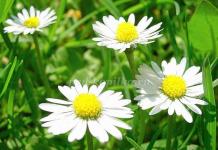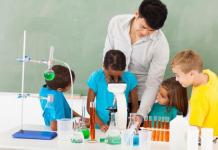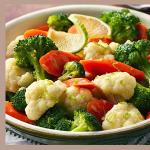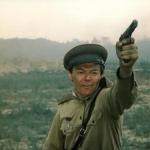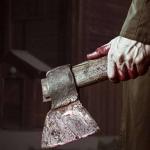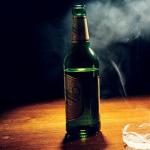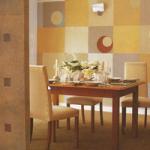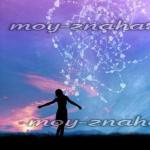Description of work: this project will be useful in the work of educators of preparatory groups, as well as parents, in order to increase parental competence in matters of pre-school preparation of children.
Carrying out purposeful work in kindergarten to educate a positive attitude towards school in children of the preparatory group, contributes to an increase in social and cognitive activity, the purposeful formation of integrative qualities in them, necessary for the successful inclusion of children in school life.
The presented material involves the use of various forms and methods of work: the creation of a subject-developing environment, pedagogical education of parents, interaction with teachers and primary school students.
Theme of the project: "Soon to school"
Implementation timeline: short-term (2nd week of April)
Project type: cognitive - creative
Children's age: preparatory group
Project participants: preschool teachers, children of the preparatory group, parents, teachers and primary school students.
Target: to form ideas about school and a positive attitude towards school life among older preschoolers.
Tasks:
Formation of learning motivation and interest in the learning process itself;
Promote the development of mutual understanding, friendliness;
Removing feelings of anxiety and doubt in preschoolers before meeting with the school;
Increasing parental competence in matters of pre-school preparation.
Project relevance:
Preparing for school is a difficult period in the life of a preschooler. Entering school and the initial period of education cause a restructuring of the child's lifestyle and activities. The little man is in a state of expectation: something very significant and attractive is coming, but as yet uncertain. The whole way of life of the child changes radically (mode, change of communication with adults and peers, increase in the amount of intellectual load).
The attitude of the child to school is formed before he goes to it. And here information about the school and the way it is presented by parents and kindergarten teachers play an important role. Many parents try to create an emotionally attractive image of the school: “You will be an excellent student,” “You will make new friends,” “Teachers love smart people like you.” Adults believe that by doing so they instill in the child an interested attitude towards school. In reality, a child tuned in to a joyful exciting activity, having experienced even minor, negative emotions (resentment, jealousy, envy, annoyance), can lose interest in learning for a long time. The school provides plenty of reasons for such emotions: failures against the background of seeming general success, difficulties in finding friends among classmates, a discrepancy between the teacher's assessment and the usual parental praise, etc.
A number of authors emphasize the need to cultivate a positive attitude towards school as a condition for successful learning in the future (J. A. Komensky, J. Locke, J. J. Rousseau, I. G. Pestalozzi, N. A. Dobrolyubov, K. D. Ushinsky, A. S. Simonovich, E. I. Vodovozova, A. S. Makarenko). Yes, and practice today is aimed mainly at the intellectual preparation of children for school and pays little attention to the formation of the "internal position of the student."
Consequently, a theoretical analysis of the literature and practice data convinced us to carry out purposeful work to educate a positive attitude towards school in children of the preparatory group using a variety of forms and methods of work, through the creation of a subject-developing environment, through pedagogical education of parents, interaction with primary school teachers.
Thus, all this can be reflected precisely in the short-term project "Soon to School". School-oriented projects help to increase the social and cognitive activity of children, the purposeful formation of integrative qualities in them, which are necessary for the successful inclusion of children in school life.
Project Implementation Plan:
Preparatory stage:
Prepare in the group the necessary material for cognitive and productive activities (development of abstracts of directly educational activities, conversations, etc.);
Prepare homework for parents, collect the necessary information and arrange it;
Help from parents in the selection of literature and desktop - printed games on school topics;
Cooperation with the school library and primary school teachers.
Main stage. Project implementation: (table)
The final stage.
Project presentation - folder design;
Creating an album with children "Riddles from the portfolio."
Presentation of children's creative drawings "What did you like at school."
Joint event of the preparatory group and 1 class of KVN
"Magic Sun"
Expected Result:
Formation of motivational readiness for school in children;
Increasing parental competence in matters of pre-school preparation;
Favorable course of the adaptation school period.
Table. Project implementation.
|
Days of the week |
Joint activity of an adult and children |
Independent activity of children |
Interaction with parents and primary school teachers |
|
|
Educational activities in the process of organizing various types of children's activities |
Educational activities carried out during regime moments |
|||
|
Monday |
Exhibition of illustrative books on school subjects and reading of the work "Filippok" L.N. Tolstoy |
"Be Kind" Conversation (polite words in the life of a future student) Purpose: to teach children to self-control their behavior. |
Examination of illustrative books. Watching the cartoon "The kid who could count to 10" Purpose: to form children's ideas about the importance of counting. |
Help parents in the selection of cartoons and board games about the school. |
|
Conversation with children How is school different from kindergarten? What do we know about the school? Purpose: to create positive attitudes towards the school. |
"Be ready!" (emphasis on the organization of regime moments, gathering for a walk, preparation for the game, joint activities, etc.) |
Watching the cartoon "Island of Errors" |
Reading books about school together with children at home. |
|
|
Game - competition "Soon to School" (games, relay races, etc.) |
Making riddles, reading proverbs about school. Purpose: to teach children to reflect their impressions in speech and drawing. Publication of the book "Mysteries from the portfolio" |
Story - role-playing game "Kindergarten" Purpose: to expand and consolidate children's ideas about the content of the labor activities of kindergarten employees. |
Making a folder - movers for parents “What aspects of readiness for school are especially important” |
|
|
Integrative activity (musical and artistic activity and drawing) "School day". Design of the exhibition of children's drawings "What did you like at school" (based on personal knowledge - excursion) Purpose: to reflect their impressions in the drawing, the ability to develop a desire to study at school. |
Looking at school supplies. Purpose: to acquaint children with school paraphernalia, its purpose. Game "Collect a portfolio" Purpose: to consolidate the knowledge of children about the purpose of school subjects. The game "What's wrong? » (school supplies and other items) Purpose: activation of the dictionary, classification of objects, development of speech. |
Story - role-playing game Purpose: to cultivate the desire to take the position of a student - a student, to be able to subordinate their desires to the collective. Watching a cartoon "Our friend Pishichitay" Purpose: to form in children the desire and understanding of the need to study at school. |
Preparing a consultation for parents "Preparing Children for School" “Advice for parents whose children are preparing for school |
|
|
Examining the painting Purpose: to expand children's ideas about school. |
"We are future students" Purpose: to form attitudes towards the responsible implementation of the rules of behavior for schoolchildren mastered during the week. |
Didactic and desktop - printed school-themed games: - "Syllabic houses" - "Number houses" - "Logic Train" - "Easy account", etc. |
Meeting with students - kindergarten graduates. (Examination of a portfolio, books, notebooks, pencil case, etc.) A joint event for children of senior preschool age and students of grade 1. KVN "Magic Sun" Purpose: to improve the ability to play team games. |
|
References:
1. Burukhina A.F. "Cartoons in educational and educational work with children" - magazine "Educator of the preschool educational institution" 2012
2. Kachigina L.B. "Creating conditions for the preparation of older preschoolers for educational activities" - the magazine "Educator of the preschool educational institution" No. 4 / 2013
Objective of the project:
for children - make a magazine about the life of the group ;
for the teacher- to promote the formation in older preschoolers of the desire and ability to independently search, collect information, develop a sense of responsibility for the task assigned.
Project objectives:
- Development of cognitive abilities.
- Development of creative imagination.
- Development of creative thinking;
- Development of communication skills.
- Formation of prerequisites for search activity, intellectual initiative.
- Developing the ability to identify possible methods for solving problems independently.
- Formation of the ability to apply methods that contribute to the solution of the task, using various options.
Problem:
Children get acquainted with children's magazines and want to create a magazine for their group.
Project type:
- By the number of participants - collective.
- According to the contingent of participants - the same age (children of the older group).
- According to the priority of the method - creative, practice-oriented.
- By duration - short-term (1 week).
Project plan:
Stage 1.
Talking about children's newspapers, magazines, looking at magazines, reading articles of the choice of children.
Visiting the children's library: acquaintance with children's magazines.
Exhibition "My favorite magazine". ( "My Mom's (My Dad's) Favorite Magazine"
Conversation about professions: journalist, correspondent, photojournalist, editor.
Stage 2.
Discussion of options for the topic of a children's group magazine, its title, headings.
Stage 3.
Magazine production.
Stage 4.
Presentation of the magazine for kindergarten children, parents.
Project passport.
One day I brought my favorite magazine to the group.
What do you think this magazine is about? Why do I love him? How did you guess? (according to the illustration on the cover and by the title).
That's right, this magazine helps me in my work: it tells about new interesting activities, games, competitions, quizzes for children. So, the appearance, the form of the magazine speaks about its content.
We already know what the magazine consists of. These are the cover and pages.
What do we see on the pages? (photos, pictures, poems, text).
What is the name of the text in the magazine? (article, report).
Here are some more magazines. What do you think they are about? How did you guess?
Guys, do you want to publish your own magazine?
What could it be about? What articles will be in it?
(“Our favorite games”, “Our activities”, “Our holidays”, “How we walk”, “We are athletes”, “Competition of attendants”, “We are friends with kids”, ...)
What do you need to design a magazine page? (photos, pictures, text).
We have photos that didn't fit in our group albums. They will be useful to us.
What materials might we need to make a magazine? (paper, pencils, felt-tip pens, glue, crayons, etc.).
Everything you need can be found on the table.
- What will be on your page of the magazine? (title, text (article), photograph or picture (or both), author's name). So, you need to think about how to arrange all this on a sheet.
- And we also need to agree on how all the pages of our magazine will be located: vertically (book layout) or horizontally (landscape layout).
I suggest you come up with a topic for your article, your report. Photos will help you with this. They will remind you of interesting events that took place in our group.
What will be the name of our magazine?
- How can I make a cover?
- Guys, who will design the cover?
The article you write will need to be written down. Who will record?
Options:
- ourselves
- ask for help. Who?
— T.A. (Unfortunately, I won't be able to help everyone. I can only write one article).
- turn to the guests, ask for help.
After the leaves are ready:
How do you put them together to make a magazine? (options are discussed: hole punch, glue, stapler)
(fasten with a hole punch).
The teacher reads the articles and shows the pages of the finished magazine.
How can we use our magazine? (show to parents, children of other groups, leave as a keepsake in kindergarten).
Nomination: projects in the preparatory group of the kindergarten.
Position: educator
Place of work: MBDOU "Kindergarten No. 31"
Location: Sarov, Nizhny Novgorod Region
Short-term projects in the preparatory group involve the use of a variety of methodological techniques that allow the kids to understand the topic under consideration.
Features of preschool age
It is this period that is the most fertile time for training and education. Preschoolers absorb information about society, the environment, relationships between adults like a sponge. At this age, active knowledge of the world is developed. Short-term projects in the preparatory group are aimed at enriching the child's personal experience, developing his independence,

The purpose of projects in preschool educational institutions
The main goal of any project is to expand the knowledge of preschoolers on a specific topic. Short-term projects in the preparatory group of the kindergarten are aimed at developing patriotic qualities in young citizens. A child from birth becomes an explorer of the world that surrounds him. He sees snow, rain, a rainbow for the first time, and faces joy and sorrow. At the age of five, little "why" try to find answers to numerous questions that interest them. Teachers and parents should help them in this.

Project Methods in Kindergarten
A short-term project in the GEF preparatory group can have a variety of topics, taking into account the predisposition of children. Educators try to use problem-based learning to develop logical thinking in their students. Short-term projects in the preparatory group are aimed at modeling non-standard situations, solving puzzles, and conducting experimental research activities.

Project topics
Integrated learning for preschools is innovative. It is aimed at developing the child's personal qualities, creative and cognitive abilities. The topics of short-term projects in the preparatory group may be related to pets. For example, a teacher introduces children to the image of a dog in the works of Russian writers and poets, artists and filmmakers. After the theoretical part of the project is presented, preschoolers receive a task in groups. One team is invited to portray a pet, the second - to write a fairy tale, the third - to come up with riddles related to the dog. At the end, each group presents the result of their activities, the end result of the lesson is the creation of a complete picture of man's best friend.
Such short-term projects in the preparatory group are aimed at the artistic and aesthetic development of the younger generation.

Variability in the use of project methods
What are the main advantages of this technique? It is equally good for both physical development and the formation of intellectual abilities of preschoolers. Among the common types of projects used, group types are in the lead.
in preschool
The transition of a kindergarten to project technology is carried out according to a certain algorithm. It involves several steps:
- conducting classes using problem situations, a small experiment;
- conducting complex block-thematic classes;
- integration of theoretical and practical knowledge on a specific topic.
A short-term project in the preparatory group for ecology, for example, involves familiarity with natural phenomena, their explanation, study.

Children's project algorithm
What are children's short-term projects? The preparatory group in the preschool educational institution involves the use of a similar methodology. The educator determines the form of organization of the educational space, selects ways for the development of creative cognitive interest in the pupils in the problem under consideration.
Plan of activities of the educator in the preparation of a short-term project
In order for such an activity to be effective, the teacher must build a clear sequence of actions.
- 1st stage. A problem is being considered, which young researchers will deal with under the guidance of an educator. In order for preschoolers to become interested in the topic of the project, it must be clear to them. Do not come up with complex scientific research for 5-6-year-old children.
- 2nd stage. Planning actions that will achieve the goal. The teacher, together with the children, determines the approximate time frame for each stage.
- 3rd stage. Search for information related to the topic of the project. At this stage, together with their parents, teacher, representatives of other organizations, the children receive theoretical knowledge on their project.
- 4th stage. Drawing up a project scheme, accumulation of material. The acquired knowledge is gradually systematized, and on their basis a scheme is drawn up. It is she who will become the basis of all subsequent work of small researchers.
- 5th stage. Practical activities. The children are offered experiments, which they can do both in kindergarten and at home.
- 6th stage. At this stage, the main burden falls on the shoulders of parents and educators. Together with the children, adults prepare a presentation in the form of a presentation, a computer presentation. All the results that have been achieved as the project progresses are presented at a public event.

in preschool
How are short-term projects divided in preschool educational institutions? The preparatory group is working according to the new federal standards. They involve the classification of projects by the number of participants, target setting, duration.
Basically, in kindergartens, the following options are used:
- Creative and research forms. Children conduct interesting experiments, the results are presented in the form of newspapers, theatrical performances, role-playing games.
- Role and game projects. They contain separate elements of games in which the main roles are played by kids.
- Practice-oriented information work. Kids collect material, then draw it up.
- Creative projects involve holding children's holidays, excursions.
Examples of projects in preschool educational institutions
We propose to consider the short-term project "Winter" in the preparatory group. The main purpose of its holding is to introduce kids to the seasons. First, the teacher tells the children about what is typical for such a season as winter. The teacher pays special attention not to the climatic features of this period, but to those traditions that this period is so rich in. As homework, kids are invited to remember New Year's traditions with their parents, come up with riddles about the New Year. In the second lesson, the guys share the information that they managed to find. The teacher introduces the children to "different" Santa Clauses. This can be done using a computer presentation. In addition, preschoolers will learn about those New Year traditions that exist in different countries.
This project is best done in November-December. The second homework will be the manufacture of New Year's toys. But first, the teacher introduces children to the types of Christmas decorations, how to make them.
As the final lesson on the project "Winter" there will be a presentation of New Year's decorations, hanging them on the Christmas tree. After the Christmas tree is decorated with handmade toys (with the help of parents), the kids will find themselves in a fairy forest, where treats and fun games await them.
"Water World"
During the implementation of this short-term project, children not only get acquainted with the most important substance on Earth, but also learn how to respect water resources.
The teacher tells his kids that they are 90 percent water. To draw the attention of preschoolers to the topic of the project, he can tell them a fairy tale about a droplet that, during its journey, turned into steam, then into ice, then back into a droplet. So the guys will get acquainted with the aggregate states of water, its circulation in nature. There is also a practical part in this project. Toddlers learn to "turn" water into ice using refrigerators. Aesthetic skills are also assumed in this activity. Armed with ordinary sheets of white paper and scissors, young designers create snowflakes of unusual shape and size. Together with the teacher, the children attach threads to the finished products, and such home-made decorations are used for New Year trees.
The project "The World of Water" involves the involvement of a music worker from a preschool educational institution. He introduces the guys to songs that mention water, snow, ice. The result of such cooperation will be learning a song about water, snow, rain. Everyone chooses a song together: a teacher, a music worker, children.
Conclusion
Project activity in a preschool institution is aimed at the formation of a creative free personality of the child. This technology provides psychological well-being, physical health of preschool children. When children are involved in a joint project, the cognitive abilities of each child develop, creative thinking develops, communication skills are formed. For younger preschool age, the result can be obtained by involving children in the game process, in which the leading role will belong to the teacher. In the older groups of the preschool educational institution, the children work on the task in groups, develop independence and curiosity. These qualities will help the children to easily and quickly adapt to elementary school. Toddlers attending kindergarten, who have acquired the skills of project activities here, will certainly be successful students in a comprehensive school.
Project passport.
Subject:"Getting ready for school by playing!!!"
Developer: Teacher of the 1st qualification category MBDOU No. 7 Maykop Avagyan Ekaterina Sosikovna
Problem:
At present, first-graders are less developed than their peers in the middle of the last century, because psychological readiness is not formed in school-type classes.
This is explained by the fact that our children play less and less traditional games (role-playing, developing, games with rules, didactic, less often engaged in designing, modeling, drawing, appliqué. All types of children's activities are being replaced by computer games. Parents strive to start systematic education of their child as early as possible, and in addition to kindergarten, they can be taken to sports sections, a music school, an art studio, etc. They do not know what education is, reduced to how as a rule, to the development of skills and abilities in a particular area, does not contribute to the mental development of the child.
School readiness is a social and communicative prerequisite for mastering learning activities, which are formed within the leading activity, that is, in the game.
Implementation timeline:
December - February
Project type:
Game, long-term, group.
Members:
Children of the preparatory group, educators, parents, teacher-psychologist.
Project justification:
An analysis of the pedagogical heritage showed that at all times teachers expressed their thoughts about preparing for schooling. It should consist in the correct organization of the life of children, the timely development of their abilities, as well as the awakening of interest in school and learning. And since in preschool childhood there is nothing closer, understandable and enjoyable for children than play, this preparation must also go through play.
Relevance:
Going to school is a major milestone in every child's life. And it's no secret that many children experience difficulties during the period of adaptation to school, a new daily routine, a team, a teacher.
The attitude of the child to school is formed before he goes to it. And here information about the school and the way it is presented by parents and educators of the preschool educational institution plays an important role.
In psychological and pedagogical research, the issues of special and general readiness of the child for school are considered. According to scientists, one of the sides of psychological readiness is the personal readiness of a preschooler for the upcoming learning, which is expressed in the motives of learning, the attitude of children to school, the teacher, school duties and the position of the student, in the ability to consciously control their behavior.
And the high level of intellectual development of children does not always coincide with their personal readiness for school. The preschooler may have
a positive attitude towards a new way of life, changes in conditions, rules, requirements has not been formed, which is an indicator of the attitude towards school. School teachers also note this discrepancy.
Since play is still the leading activity in preschool childhood, we see that it is more comfortable for children to prepare them for school with the help of gaming technologies.
Novelty:
Development of such a model of gaming technologies, with which you can prepare children for school.
Target:
Formation of a positive attitude of children to the upcoming schooling, personal qualities, adequate self-esteem and psychological readiness in general with the help of gaming technologies.
Tasks:
Educational:
creation of a subject-developing environment for familiarizing pupils with the school (didactic and plot-role-playing games);
acquaintance of children with the school and the profession of a teacher in role-playing games;
Developing:
The development of psychological functions necessary for learning at school through didactic and role-playing games;
Strengthening physical and mental health through sports and outdoor games;
Educational:
fostering a positive attitude towards school in children of the preparatory group.
Stages of work:
I stage - organizational and preparatory:
Statement of the problem - “How to “comfortably” prepare children for school?”;
The study of literature on the topic;
Preparation of the subject-spatial environment;
II stage - reflective-diagnostic:
Identification of the level of motivational readiness of children for school;
Parent survey.
III stage - practical:
Project implementation through:
Role-playing games;
Didactic games;
Outdoor games;
Productive activity;
Working with parents.
Obtaining the product of the project - making the album “What I see as a school”;
Photo exhibition "Soon we will go to school!"
IV stage - final:
Questionnaire for parents "What do you know about preparing children for school?"
(parents with children)
Presentation of the project at the teachers' council;
Project analysis.
Expected results:
motivation to study;
development of arbitrariness;
the formation of visual-effective and visual-figurative thinking;
development of spatial representations;
development of cognitive processes;
manifestation of independence.
Long-term planning of project activities
1st stage - organizational and preparatory
| Events | Timing | Result |
|
| With teachers |
|||
| Study and analysis of research, methodological literature, Internet resources on this issue; selection of software and methodological support for this problem; visual-demonstration, handout material | 1-2 week of December | Increased competence of teachers on the topic |
|
| With pupils |
|||
| Statement of the problem “How to “comfortably” prepare children for school?” | 1-2 week of December | Children have an interest in the upcoming activities. |
|
| Development of the content of the project | 1-2 week of December | The main directions of the project implementation and expected results are determined |
|
| Preparation of the object-spatial environment | Attributes for role-playing games, didactic and board games have been prepared. |
||
| With parents |
|||
| Introducing parents to the upcoming project. | 1-2 week of December | There was interest in the upcoming activities. |
|
2nd stage - reflective-diagnostic
| Events | Timing | Result |
|
| With teachers |
|||
| Identification of perceived difficulties | 2-3 week of December | Expected difficulties are identified. |
|
| With pupils |
|||
| "Interview" with children - "What is a school?" | 2-3 week of December | The level of psychological readiness of children for school was determined. |
|
| With parents |
|||
| Questionnaire for parents "What is school readiness?" | 2-3 week of December | The level of competence of parents in preparing children for school has been determined. |
|
3rd stage - practical
| Educational area | Events | Timing | Result |
|||
| With teachers |
||||||
| Consultation "How to "comfortably" prepare children for school" | 2nd week of January | The competence of teachers on the topic has been increased. |
||||
| With pupils |
||||||
| 1 | Social and communicative development | Dramatization "Rules of conduct at school" Creating a problem situation - "You are called to indulge in a break"; “There is a lesson, but you want to play” | January - 1st week of February | They know how to change the role-playing action during the implementation of the game. |
||
| 2 | C / r games: "School": Plots - "The teacher teaches a lesson - the children perform his tasks"; "The bell rings - change"; “The head teacher distributes the class schedule”; “Library” | Children can create their own play environment for their plans. They are able to creatively develop the plots of the game. |
||||
| 3 | Board games for the development of logic, attention, memory, thinking, graphic dictations. | In game interaction, the development of learning skills. |
||||
| 4 | Intellectual game "Clever and clever" | Children through game interaction have the experience of conducting discussions on various topics. |
||||
| 5 | Role-playing game "Cunning Dwarf" Creating a problem situation - "We need to find the same image that the dwarf shows for a short time" | Through the game, the memory and visual attention of the child are developed. |
||||
| 1 | cognitive development | Excursion to the school | Children are familiar with the school |
|||
| 2 | Presentation: "School of the Past and Present" | With the help of computer technology, children have the opportunity to "plunge" into the past. |
||||
| 3 | Construction "My school" | Children through productive activities have the opportunity to express their ideas about the school. |
||||
| 1 | Speech development | Who are first graders? | Through the artistic word, the expansion of knowledge about the school. |
|||
| 2 | Drawing up a monologue story - “Why do I want to go to school?” |
|||||
| 3 | What will my first day of school be like? (fantasy story) |
|||||
| 4 | Analysis and memorization of proverbs |
|||||
| 5 | Reading fiction: In Dragunsky "Where is it seen, where is it heard", "The Enchanted Letter", "Amazing Day" A. Barto "To School" G. P. Shalaeva "The Big Book of Rules of Conduct" N. Nosov "Dreamers" V. Oseeva "The Magic Word", "Why?" Y. Koval "Zero class" V. Golyavnin "No luck" "Carousel in the head" |
|||||
| 1 | Artistic and aesthetic development | Application "What will I take to school" | January - 1st week of February | In productive activities, knowledge about the school, school supplies is fixed. |
||
| 2 | Modeling "The most beautiful briefcase" |
|||||
| 3 | Drawing "My future teacher" |
|||||
| 1 | Physical development | Conversation: "My daily routine." "How We Harden" "Strong and smart" | January - 1st week of February | Development of motor skills and health promotion. |
||
| With parents |
||||||
| 1 | Consultation: « Child's readiness for school » | January - 1st week of February | The competence of parents on the development of the child has been increased. |
|||
| 2 | Photo exhibition "Mom and Dad were also first-graders" | Parents can understand the psychological state of their child through their memories. |
||||
| 3 | Workshop "Playing, getting ready for school" | Parents have ideas about playing ways to prepare children for school. |
||||
| 4 | The competence of parents on the development of volitional qualities and prerequisites for educational activities has been increased. |
|||||
| 5 | Presentation at the parent meeting "How we "went" to school" | Parents can compare their children at different ages. |
||||
| With society |
||||||
| Coverage of the progress of the project on the website page | During project implementation | Openness of project implementation activities. |
||||
4th stage - final
| Events | Timing | Result |
|
| With teachers |
|||
| Presentation of the project at the teachers' council | 2nd - 4th week of February | Teachers have an idea about the project and project activities. |
|
| Project analysis | 2nd week of February | The result of the project has been determined. |
|
| With pupils |
|||
| Phototape "Soon we will go to school" | 2nd - 4th week of February | The result of the work on the project is presented. |
|
| Presentation of the product of the project - the album "What I see as a school" | 2nd - 4th week of February | Children have the opportunity to express their ideas about the school |
|
| With parents |
|||
| Questionnaire for parents "What do you know about preparing children for school" | 2nd - 4th week of February | The level of knowledge acquired by parents on the topic of the project was determined. |
|
| Intellectual game "Clever and clever" | 2nd - 4th week of February | Parents and children have experience of working together. Parents have an idea about the intellectual abilities of their children |
|
| With society |
|||
| 4th week of February | The interest of parents in the project was revealed. |
||
Project support:
A.K. Bondarenko, Didactic games in kindergarten, M - Enlightenment, 1991.
and. Educator of a preschool educational institution, No. 5/2007, M - Creative Center Sphere.
and. Handbook of the senior preschool teacher
No. 2/2008, No. 9/2008, No. 9/2011, M - MCFER
Internet resources.
Klyagina Daria
PROJECT PLAN
"STORIES TOLD BY DISHES"
in the preparatory group
The project was prepared and carried out by: Volk T. I., Klyagina D. B., Korneva N. Yu., Suvorova E. V.
Objective of the project: the formation of children's cognitive interest in the world around them of things created by people, through familiarization with the history of the emergence and improvement of dishes and the organization of cognitive, productive and creative activities.
Tasks:
1. To introduce children to the history and reasons for the further improvement of the spoon, plate and cup.
2. Introduce children to the production process of porcelain and earthenware.
3. Conduct experiments that allow you to recognize the materials from which the dishes are made.
4. Develop children's artistic creativity skills.
5. Create conditions for creativity by including new materials (disposable tableware) in the productive activities of children.
6. Promote the development of speech: enrich and activate the vocabulary, develop verbal communication skills in joint activities.
7. Develop fantasy, imagination in the process of performing creative tasks.
Project participants: children, teachers of preparatory groups, parents.
Project duration: October 2014
Project plan.
1. Lesson-conversation on the presentation "History of the spoon".
Tasks: introduce children to the history of the invention of the spoon; with the materials from which spoons were made and are being made; with kinds of spoons, develop cognitive interest.
2. Conducting an experiment: "Which spoon is more convenient to eat: wooden or metal?"
Tasks: determine empirically whether metal and wooden spoons heat up from hot food; Which spoon shape is best for eating?
Experience: each child was asked to eat soup during lunch with a wooden spoon, and then a metal one.
Conclusion: a wooden spoon, unlike a metal one, does not burn the lips, as it does not heat up. Regarding the convenience of eating, the opinions of children were divided: some children put aside a wooden spoon and continued to eat with a metal one, since the shape of a wooden spoon is round and it did not fit into the mouth; other children happily finished the soup with a wooden spoon, saying that if you turn the spoon sideways to your mouth, that is, it is convenient to get out of it.
3. Modeling lesson "Ladybug".
Tasks: improve the technique of constructive modeling; teach children to create an image of a ladybug using non-standard material - disposable spoons; develop a sense of form, proportion, eye.

4. Drawing lesson "We paint wooden spoons."
Tasks: to introduce children to the art of Khokhloma painting on wooden spoons; continue to teach children to work on three-dimensional forms; develop a sense of color and composition; create conditions for the artistic creativity of children.
5. Design lesson "Dolls from disposable spoons".
Tasks: teach children to work with corrugated paper; create images of little men using non-standard material - disposable spoons; develop fine motor skills.

6. Listening to folk music performed by the Lozhkari ensemble.
Tasks: teach children to hear how wooden spoons sound; evoke an emotional response to Russian folk melodies.
7. Lesson-conversation on the presentation "History of the plate".
Tasks: introduce children to the history of the invention of the plate; with the materials from which the plates were made and are made; with kinds of plates, develop cognitive interest.
8. Lesson on the application "Ice cream".
Tasks: learn to use unusual materials in the appliqué class (disposable plates, beads); arouse interest in the independent search for visual means to create the image of delicious ice cream; continue mastering the “overlay” technique, develop a sense of form and composition; educate children in artistic taste.
9. Modeling lesson “Decorative plate “Hedgehog”.
Tasks: to exercise children in an unconventional technique - plasticineography; to develop in children a sense of composition and color; develop fine motor skills of fingers; to form an aesthetic attitude to household items (plates).

10. Work in the book corner: selection of illustrations and pictures on the topic “What is the dish like?”.
Objectives: to consolidate the knowledge gained during the project lessons; expand children's ideas on the topic "Dishes"; maintain interest in the topic of the project.
11. Watching the video "How porcelain is made."
Tasks: introduce children to the production of porcelain; expand the vocabulary of children ("blank", "gypsum form", "kaolin"); develop curiosity.
12. Lesson-conversation on the presentation "History of the Cup".
Tasks: introduce children to the history of the invention of the cup; with the materials from which cups were made and are being made; with kinds of cups, develop cognitive interest.
13. Conducting an experiment: “How to distinguish a faience saucer from porcelain?”, “What do clay, earthenware and porcelain cups sound like?”
Tasks: empirically determine how a porcelain saucer differs from earthenware, if they are brought to a light source; empirically determine what sound cups made of different materials make when they are struck with a wooden stick.
Experience: children first took a porcelain saucer and pointed it at a light source, then they took a faience saucer and pointed it at a light source.
Conclusion: fingers are visible through a porcelain saucer. The fingers were not visible through the faience saucer. This means that porcelain differs from faience in that it is transparent in the light.
14. Drawing lesson "Cups from Gzhel".
Tasks: to introduce children to the art of painting on ceramics in Gzhel; to improve the ability of children to obtain the desired shades of colors by mixing colors; develop a sense of color and composition; create conditions for the artistic creativity of children.

15. Watching the video "How pottery is made."
Tasks: introduce children to the work of a potter; develop cognitive interest; enrich ideas about the work of adults and the vocabulary of children (potter, potter's wheel, glaze).
16. Modeling lesson "Sculpt a cup."
Tasks: introduce children to the material - clay; teach children to sculpt a cup of clay in a sculptural way; develop a sense of form, proportion, eye, consistency in the work of both hands.

17. Drawing lesson "We paint a cup."
Tasks: to acquaint children with the features of painting clay products; continue to teach children to work on three-dimensional forms; develop a sense of color and composition; create conditions for the artistic creativity of children.

18. Reading literary works about dishes.
Tasks: to teach children to emotionally perceive the figurative content of works, to comprehend the characters of the characters; exercise children in the selection of comparisons, synonyms, antonyms.
19. Working with the family.
Inventing a fairy tale about a spoon, plate or cup by a child with the help of adults.
Tasks: update the knowledge gained by children during the project; create conditions for creative communication between parents and children; draw the attention of parents to the activities taking place in the group.
20. Design of an exhibition of children's works on the project.
Tasks: show the results of the project to parents, colleagues; please the children.
21. Creation of a manual-book for the group "Stories told by dishes".
Tasks: prepare a manual-book based on the project materials for further use by children and educators.




